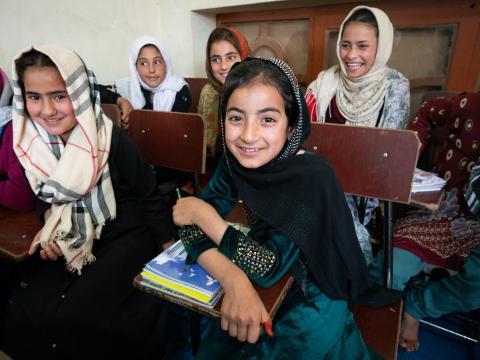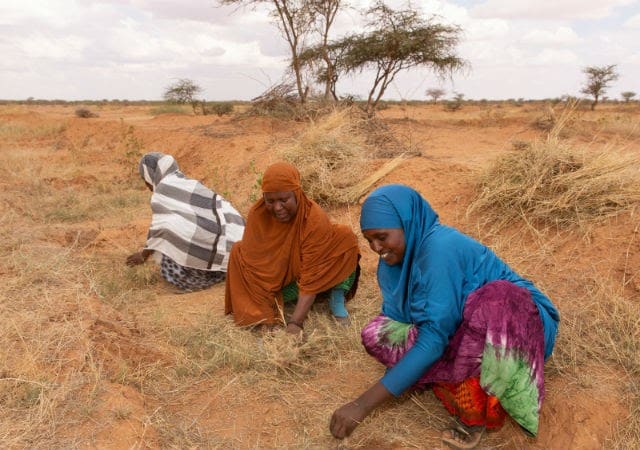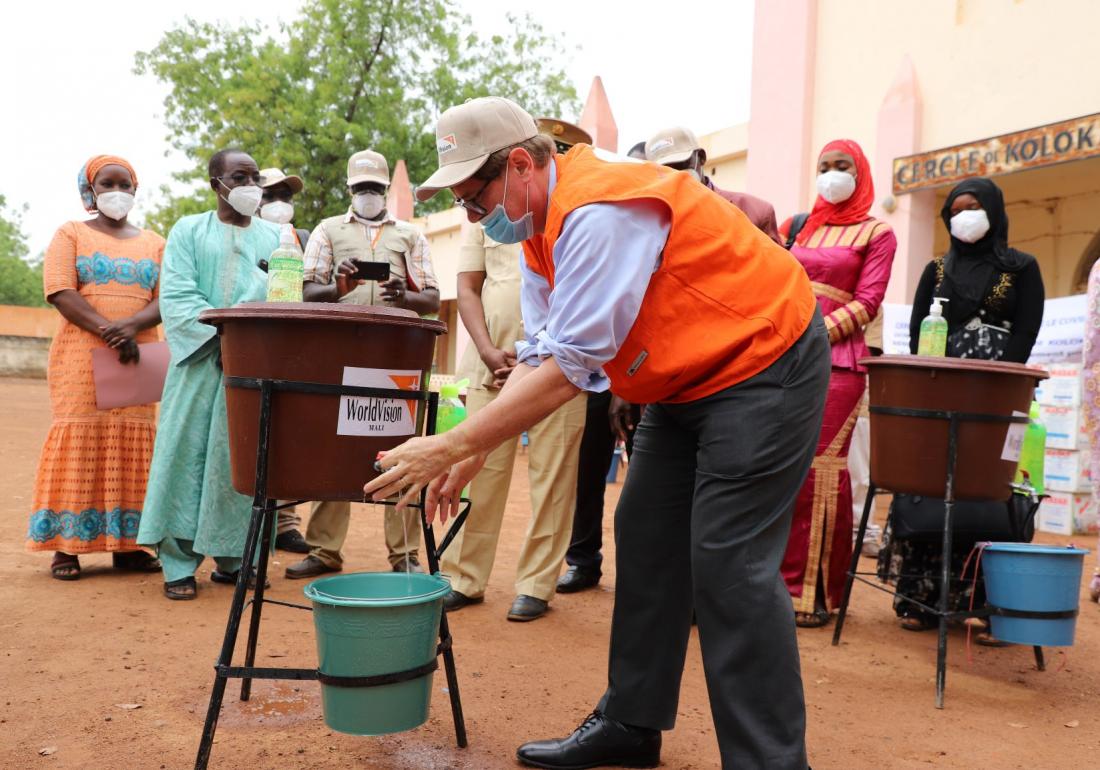Embracing Stronger Partnerships across the Nexus: World Vision’s story

Summary: In this joint blog post with CDA Collaborative Learning, Maya Assaf-Horstmeier, Director of Peacebuilding and Conflict Sensitivity, writes about a new approach for adaptive programming in the humanitarian, development, and peacebuilding Nexus. She offers key learning and insights about the importance of trust, collaboration, and flexibility in partnerships that can allow for more effective activities in these challenging contexts.
Changing Landscape
Today, humanitarian and development professionals are faced with some of the most challenging and complex circumstances in history. To name a few, we are seeing conflicts increasingly become protracted; climate-related shocks are more intense and frequent; and we are seeing the splintering of rebel, tribal, and extremist groups across the globe, permeating the dynamics of conflict itself. In addition, the dawning of new pandemics, such as COVID-19, have shaken the foundations of the current way that humanitarian and development agencies work.
As discussed in other blogs in this series, the COVID-19 pandemic has forced the sector explicitly to urgently grapple with its reluctance to shift towards greater local leadership, ownership, and power. As Alex Martins offers in her post, “Some believe the pandemic provides an opportunity for rupture and innovation; others think it will only exacerbate the deep inequities, especially racial ones, of the development system.”
We have seen with the COVID-19 response that what we are experiencing is not just a health pandemic, as the response efforts have highlighted deeper challenges to the way that we work. In this moment, we are seeing that while there has been a lot of coordination between and among actors responding to the pandemic, the response itself is being managed through the traditional structures of humanitarian and development aid, without much thought of the development, humanitarian, and peacebuilding nexus (Nexus) approach. As I have watched the reapplication of the same approach, I am left to wonder: How could interventions across the nexus be more relevant, more localised, and therefore more sustainable? What have we as World Vision learned about this?
Through my experience, I have seen that the linear approach of a multi-mandated organisation from emergency response, then to recovery, and transition back into development has proven to have major gaps in contexts characterized by uncertainty, underlying conflict, natural disasters, and pandemics. After years of working in fragile contexts, World Vision has seen the failures of working in this linear manner, which has encouraged silos as well as created a disconnect between short and longer-term community interventions. And so we asked ourselves: Is there a new method that can capture the fluid and ever-changing nature of the contexts in which we work?
To respond to this question, in 2018 we put together a programming approach to better allow staff and partners, in the most difficult places, to adapt their programmes according to the changes in context and new needs on the ground. The approach, known as the Fragile Contexts Programming Approach (FCPA) relies on a number of consistent practices, one of which is cultivating and supporting robust partnerships with local colleagues, actors, and organizations.
How does the approach work?
Specifically, the FCPA initiative responds to the concept of linearity and enables us to work across the Nexus through an adaptive approach to programming. It is also consistent with “Our Promise”, World Vision’s 2030 strategy to work with the most vulnerable children in difficult contexts. To make the biggest impact on the lives of vulnerable children, we chose to focus on addressing both “in” fragility to ensure the survival of children and their families in these difficult contexts, but also “on” fragility to address its root causes through our interventions.
At the heart of this approach we apply three different modes, which we refer to as “dials”. They are agile planning devices that help programme designers to think in advance about a menu of programming options and adaptations that they may need to employ in their context. This enables them to be ready to respond quickly, and to predict scenarios that are likely to play out in the context. The three dials reflect the three “types” of contexts our programmes work in – emergency, transition, and long-term development.
- The Survive dial (emergency response) is linked to programming options which allow a quick and effective response to rapidly deteriorating situations, to ensure the survival of the most affected and most vulnerable children, families, and communities.
- The Adapt dial (recovery) is primarily focused on resilience and recovery, which enables longer-term change as well as prepares for a better response, reduces the likelihood of relapse and mitigates the impact of future crises.
- The Thrive dial (long-term development) is primarily used when there are signs that the environments where we work are becoming increasingly stable. Types of interventions that could be pursued during this dial are addressing underlying causes of fragility, addressing child well-being as well as social accountability work.
Project staff and local partners are able to “dial up” or “dial down” depending on emerging changes to the contexts in which they are working. This allows an office to switch swiftly from one operational modality to another quickly and with ease. For example, if a sudden bout of violence occurs during an election, an office may determine (based on a context analysis) that the emerging programmatic focus should be on Survive, as opposed to the Thrive. This may mean they respond to more immediate emergency needs like food and shelter and less on things like extracurricular school clubs. Once the context becomes more stable, the office might tune up to the Adapt dial, re-establishing the clubs and focusing them on interventions related to recovery and resilience.
What have been our biggest challenges?
Since 2018, World Vision has tested the FCPA model in a number of fragile contexts (such as South Sudan, the Democratic Republic of Congo, and Afghanistan) as well as countries with pockets of fragility (such as Burundi, Mali, and Honduras). Testing this new way of working and thinking has not been easy, because it is new to our team and for our partners.

Specifically, we have experienced challenges related to how to implement the FCPA in practice. For example, while we had “seed funding” to start implementing the approach in different countries, field offices had to look for additional private funding and grants to build on the existing programme. It was hard to explain to local partners that finding flexible funding either to expand or extend a project would depend on donor interest. Right now, World Vision is working on new and innovative ways to fund FCPA programming from a mix of different sources (private funding, grants, etc.). The lessons continue, as does the quest for flexible resources to take it to scale.
We also struggled to determine where to “house” the FCPA approach (e.g. who to manage it and oversee the mainstreaming of the initiative) in the systems of our organisation. Internal silos had to be taken down at multiple levels, rules were reassessed and broken, minds had to be stretched and assumptions challenged. For example, in FCPA pilot countries, World Vision local development staff had to work very closely with emergency response colleagues while designing programmatic interventions for most likely, best, and worst-case scenarios. “Before, we were working in separate offices, and we barely talked to each other”, said a World Vision staff from South Sudan. She continued, “The FCPA has created a more homogeneous working environment. No matter how our interventions look like, we now at least have a common goal – that of improving the lives of children in the most vulnerable areas”.
What did we learn from our local partners in applying FCPA?
From our previous work in fragile contexts, we have learned that we cannot have a sustainable impact unless we worked with local partners. Working with partners to foster greater, longer-term, and more effective and sustainable impacts is in line with the localisation agenda. From our experience, strong partnerships can offer greater leverage in humanitarian, development, and peacebuilding efforts to address fragility, co-create solutions, advocate for change, and open new investments (including appropriate funding). It also avoids duplication of efforts, while strengthening local leadership and ownership, which ultimately contributes to community resilience in the longer-term.
Working with local partners and actors on this approach has also taught us a lot, in terms of what challenges we can face, and how to mitigate those. Over the past few years we have gathered some significant lessons learned about how best to work with local partners in these highly volatile contexts.
Applying an adaptive approach to working in the Nexus with partners has taught us:
- It is paramount to select our local partners based on a conflict-sensitive stakeholder analysis to make sure there is representation from all different community groups.
- In order to contribute to durable solutions, we need to work very closely with local authorities and municipalities (especially in urban contexts, and within consortia). FCPA designs should build on existing municipal plans to strengthen existing local capacities.
- Working with the business and private sector in addition to the usual actors (like local NGOs and faith-based organizations) is also important, as it fosters corporate social responsibility and is also an approach to community sustainability.
- Partner relationships are strengthened using a two-way learning process, co-design and implementation approaches, capacity building plans, and with clear lines of communications for key issues. Clear communication ensures partnerships move towards being transformative rather than purely transactional. This for us is very important because as an organisation, we want to make sure that with time, our partners gain the skills and capacity needed to manage adaptive programmes by themselves.
- It is really important to have flexible systems (i.e. finance, procurement) to ensure smooth and effective relationships with local partners. This includes ensuring that contracts and partnership agreements are developed together and allow for significant changes given the contexts in which we are working.
- And last but not least, trust between our office and partners is the main keyword while working with partners. By being open, transparent, and ensuring that a two-way communication line is always available, we have been able to gain the trust of our partners, and we also show them that they’re capable of managing their own projects.
What next for partnerships in the Nexus?

For a multi-mandated organisation like World Vision, working across the Nexus with local partners and communities is not a new concept. Contexts like Afghanistan, Somalia, and South Sudan have taught us that without local-level partnerships, we might risk being short-sighted and have little or no long-term impact on communities affected by fragility. However, what has changed since the inception of the FCPA is the organisation will begin to break the silos and work more closely with humanitarian, development, and peacebuilding partners towards increasing impact, investment, and presence in fragile contexts. As a child-focused and community-based organisation, World Vision is a strong believer that a Nexus approach through local partnering will help both local staff and communities to understand root causes of fragility as well as be able to respond to shorter-term humanitarian needs when necessary. In contexts where we see agility and flexibility as being paramount to programming relevance, it is the local actors who will be the first people to react in face of context changes. Therefore, empowering them and investing in their capacity will be a priority as we seek to achieve positive change for the most vulnerable children and their communities.